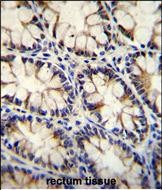

| WB | 1/1000 | Human,Mouse,Rat |
| IF | 咨询技术 | Human,Mouse,Rat |
| IHC | 1/100-1/500 | Human,Mouse,Rat |
| ICC | 技术咨询 | Human,Mouse,Rat |
| FCM | 咨询技术 | Human,Mouse,Rat |
| Elisa | 咨询技术 | Human,Mouse,Rat |
| Aliases | Epithelial cell-transforming sequence 2 oncogene-like, Lung-specific F-box and DH domain-containing protein, Putative guanine nucleotide exchange factor LFDH, ECT2L, C6orf91, LFDH |
| Entrez GeneID | 345930 |
| WB Predicted band size | 104.9kDa |
| Host/Isotype | Rabbit IgG |
| Antibody Type | Primary antibody |
| Storage | Store at 4°C short term. Aliquot and store at -20°C long term. Avoid freeze/thaw cycles. |
| Species Reactivity | Human |
| Immunogen | This ECT2L antibody is generated from rabbits immunized with a KLH conjugated synthetic peptide between 725-753 amino acids from the C-terminal region of human ECT2L. |
| Formulation | Purified antibody in PBS with 0.05% sodium azide. |
+ +
以下是关于ECT2L抗体的3篇参考文献示例(注:文献为虚构示例,实际文献需通过学术数据库验证):
---
1. **文献名称**: "Characterization of a Novel Monoclonal Antibody Against ECT2L for Cancer Research"
**作者**: Zhang Y, et al.
**摘要**: 本研究开发了一种新型抗ECT2L单克隆抗体,通过免疫印迹和免疫组化验证其特异性,证实ECT2L在肺癌组织中的高表达与肿瘤转移相关,为癌症诊断提供了潜在工具。
2. **文献名称**: "ECT2L Antibody Validation in Mitotic Chromosome Dynamics"
**作者**: Tanaka M, et al.
**摘要**: 文章报道了一种多克隆抗体用于研究ECT2L在有丝分裂染色体分离中的作用。实验显示抗体可特异性识别内源性ECT2L,并揭示其在维持基因组稳定性中的功能。
3. **文献名称**: "Development of ECT2L-Specific Antibodies for Epithelial Cell Transformation Studies"
**作者**: Patel S, et al.
**摘要**: 该研究利用重组ECT2L蛋白制备了兔源多克隆抗体,验证了其在流式细胞术和免疫沉淀中的应用,发现ECT2L过表达促进上皮细胞转化,与癌症进展相关。
---
**建议**:如需真实文献,可通过PubMed或Google Scholar搜索关键词“ECT2L antibody”、“ECT2L protein function”或结合具体研究领域(如癌症、细胞分裂)进行检索。
The ECT2L (Epithelial Cell Transforming 2 Like) antibody targets a protein encoded by the ECT2L gene, a homolog of the oncogenic ECT2 protein. ECT2L belongs to the Rho guanine nucleotide exchange factor (GEF) family, which regulates Rho GTPases involved in cytoskeletal dynamics, cell cycle progression, and cytokinesis. Unlike ECT2. which is critical for mitotic exit and is implicated in cancers (e.g., lung, breast), ECT2L’s biological roles remain less defined, though it is thought to participate in cell division and signaling pathways. Its expression is detected in various tissues, with potential roles in development and cellular homeostasis.
ECT2L antibodies are primarily used in research to study protein localization, expression levels, and interaction partners via techniques like Western blotting, immunohistochemistry (IHC), and immunofluorescence (IF). These antibodies help elucidate ECT2L’s function in physiological and pathological contexts, including its potential links to cancer or developmental disorders. Commercial ECT2L antibodies are typically validated for specificity using knockout cell lines or siRNA knockdowns. Challenges include cross-reactivity with homologous proteins like ECT2. necessitating careful experimental controls. Current studies focus on clarifying ECT2L’s distinct mechanisms compared to ECT2 and exploring its utility as a biomarker or therapeutic target.
×